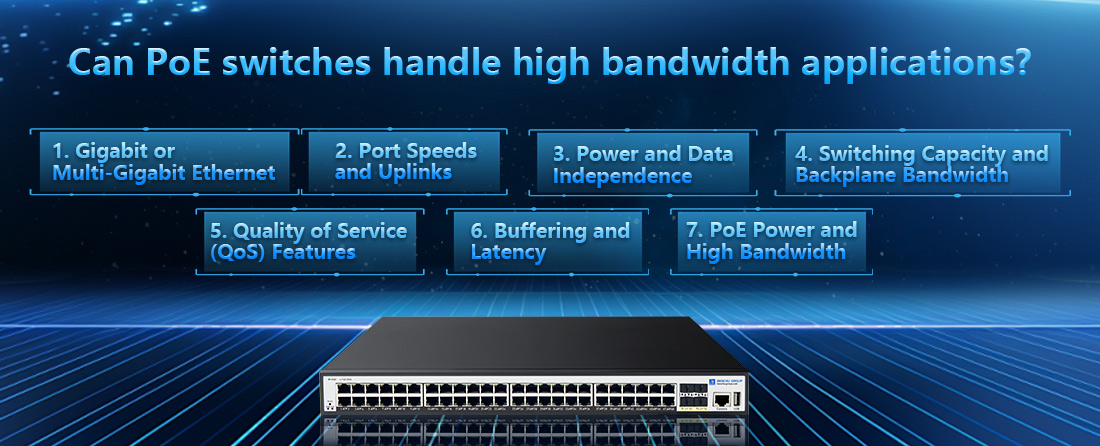
Yes, PoE switches can handle high bandwidth applications, particularly those that are Gigabit Ethernet (1 Gbps) or higher. However, the ability to manage high bandwidth depends on the following factors:
1. Gigabit or Multi-Gigabit Ethernet
Gigabit PoE switches provide up to 1 Gbps per port, which is suitable for most high-bandwidth applications like:
--- HD video streaming
--- IP surveillance systems with multiple cameras
--- Voice over IP (VoIP) services
--- Wireless access points
For even more demanding environments, some switches support 10 Gbps or multi-gigabit Ethernet (2.5 Gbps or 5 Gbps), ensuring higher data transfer rates for ultra-high bandwidth tasks like:
--- 4K/8K video surveillance
--- Data center operations
--- Advanced cloud computing applications
2. Port Speeds and Uplinks
--- A high-performance PoE switch with Gigabit or 10G uplink ports ensures that the aggregated data from multiple devices can be handled without bottlenecking.
--- Uplink ports connect to higher-tier network devices (e.g., routers or core switches), allowing multiple high-bandwidth devices to operate simultaneously without overwhelming the switch's capacity.
3. Power and Data Independence
--- PoE switches transmit power and data independently. This means that powering devices such as IP cameras, wireless access points, or IoT devices won’t interfere with the data transmission, ensuring that high-bandwidth applications continue to run smoothly.
4. Switching Capacity and Backplane Bandwidth
--- Switching capacity (the total amount of data a switch can handle) and backplane bandwidth (the maximum internal data flow rate between ports) are critical for handling high traffic. A Gigabit PoE switch with a large switching capacity can handle more simultaneous data streams without slowing down.
--- For example, a 24-port Gigabit PoE switch with a 48 Gbps backplane ensures that all ports can operate at full speed without congestion.
5. Quality of Service (QoS) Features
--- Many advanced PoE switches come with QoS (Quality of Service), which prioritizes critical traffic, such as video streaming or VoIP, over less urgent data. This ensures that high-bandwidth, latency-sensitive applications continue to run smoothly even when the network is under heavy load.
6. Buffering and Latency
--- PoE switches often include large buffer sizes to accommodate spikes in network traffic, reducing latency (delay) and improving performance for real-time applications like video conferencing or online gaming.
7. PoE Power and High Bandwidth
--- While the power aspect of PoE (Power over Ethernet) delivers electricity to devices, this does not affect the switch’s data bandwidth. Thus, a PoE switch that provides power to devices like IP cameras can still support the data throughput required for high-bandwidth applications.
Use Cases for PoE Switches in High-Bandwidth Applications:
IP Surveillance Systems: High-definition (HD) or 4K IP cameras require a combination of high bandwidth and reliable power. PoE switches are ideal for this, providing both the data transfer speeds and the necessary power.
Wireless Access Points (WAPs): High-performance access points that support large numbers of users or devices, such as in office buildings or public spaces, require Gigabit PoE switches for stable, high-speed data transmission.
VoIP Systems: Voice traffic, especially in enterprise environments, requires fast, stable connections with minimal latency. Gigabit PoE switches help ensure this by providing sufficient bandwidth for clear, uninterrupted calls.
In summary, Gigabit PoE switches and above are well-suited for high-bandwidth applications. For environments with even higher data demands, multi-gigabit or 10G PoE switches should be considered to ensure optimal performance.